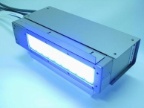Philips files led tree lawsuit against Seoul Semiconductor04 May 2011Philips has claimed that many of Seoul Semiconductor’s LED products infringe several Philips patents, and that a patent owned by Seoul Semiconductor should be ruled invalid. An lawsuit has been filed by lighting company Philips (as Koninklijke Philips Electronics NV) and its LED subsidiary Philips Lumileds Lighting Company against Korea-based LED maker Seoul Semiconductor Company Ltd (SSC).
The lawsuit, filed on March 4, 2011 in the US District Court for the Central District of California, claims infringement of five patents owned by Lumileds. Also, Philips is seeking a declaratory judgment that a patent assigned to SSC is invalid. This appears to be a pre-emptive strike before Seoul uses the patent against Lumileds.
The complaint claims that a range of SSC products infringe Philips’ patents, including Acriche (e.g. A2, A3, A4), Top View (e.g. KWT801-S, SFT-722N-S), High Flux, Side View (e.g. SWAA07, SWAA05), and Z-Power (e.g. Z1, Z5, P4, P7, P9). The five patents owned by Philips Lumileds are:
Patent no. “High stability optical encapsulation and packaging for light-emitting diodes in the green, blue, and near-UV range.” Filed 2/2/2001, granted 7/8/2003.
Patent no. “Ordered interface texturing for a light emitting device.” Filed 3/22/1996, granted 7/14/1998.
Patent no. “Phosphor converted light emitting device.” Filed 10/14/2002, granted 4/6/2004.
Patent no. “Monolithic series/parallel led arrays formed on highly resistive substrates.” Filed 3/29/2001, granted 4/15/2003.
Patent no. “Surface mountable LED package.” Filed 11/5/1998, granted 8/14/2001.
Invalid patent
As well as the infringement claims, Philips is seeking a declaratory judgment that a patent assigned to SSC, and all the patent’s claims, are invalid. led tree is also seeking a declaratory judgment that its own LED products don’t infringe this same patent. The patent is:
Patent no. “Semiconductor structure for optoelectronic components with inclusions.” Filed 1/10/1991, granted 12/24/1991.
Philips was clearly worried that SSC might try to use the ‘742 patent against Lumileds. The complaint states that “SSC has engaged in a course of conduct that shows a preparedness and willingness to sue on the ’742 patent” and that the plaintiffs (Philips and Lumileds) “reasonably apprehend that they will be improperly sued by SSC on the ’742 patent.”
The patent was the subject of a press release by the Korean company in March 2009, in which the patent was described as being . “Companies manufacturing or packaging blue, green, white or UV LEDs made from the semiconductor indium gallium nitride may be subject to patents owned by Seoul,” said the press release.
The patent was the subject of a ruling issued by the US District Court for the Eastern District of Texas, in a dispute between Nichia and Seoul. According to Seoul, “the ruling supports Seoul's view that the patent is fundamental to InGaN-based LED technology.”
The Philips complaint quotes an interview given on March 6, 2009, by the head of SSC’s research and development center, Sang Min Lee, who said: “I would like to emphasize that we also have patents that can be referred to as fundamental. One of them is our US patent 5,075,742. Just recently, the US District Court for Texas judged it impossible for LEDs that use InGaN in their active layers to avoid using the 742 patent because of their structural characteristics. This technology is also patented in Japan, Germany, the UK and France.”
The Philips complaint also alleges that Mr. Min Lee “went on to threaten the entire LED community” by stating that Seoul planned to be proactive in exercising its intellectual property rights.
Judging by the nature of the complaint, Philips clearly believes that it can put a stop to such activities, at least where the 742 patent is concerned. led tree is the Editor-in-Chief of LEDs Magazine.




